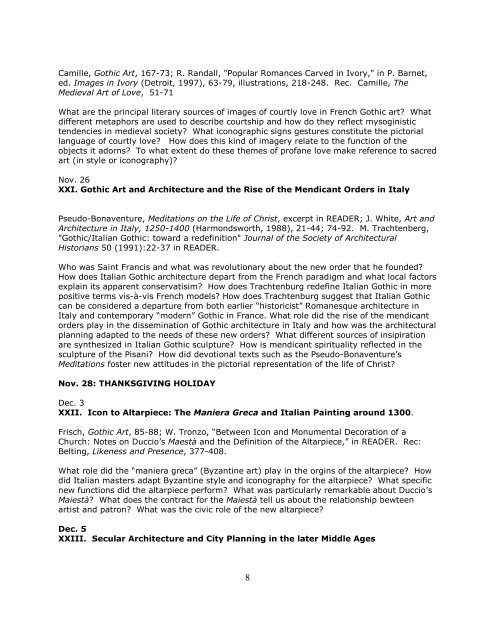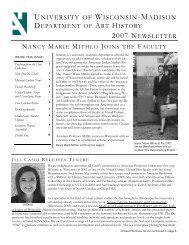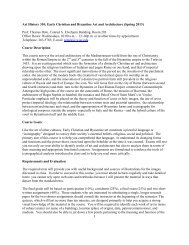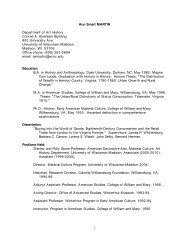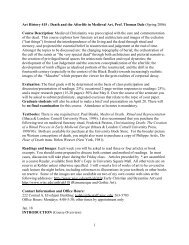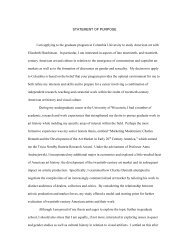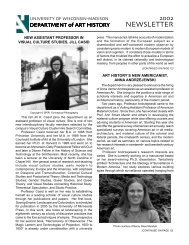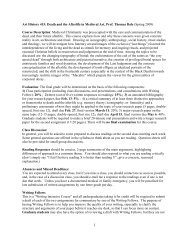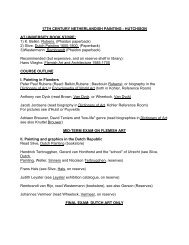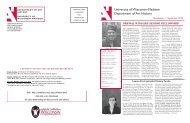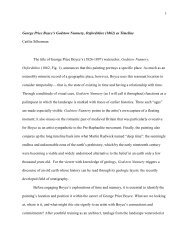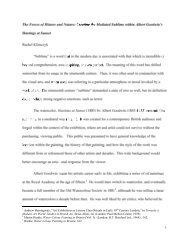Romanesque & Gothic Art & Architecture (Fall 2005) Prof. T. Dale ...
Romanesque & Gothic Art & Architecture (Fall 2005) Prof. T. Dale ...
Romanesque & Gothic Art & Architecture (Fall 2005) Prof. T. Dale ...
You also want an ePaper? Increase the reach of your titles
YUMPU automatically turns print PDFs into web optimized ePapers that Google loves.
Camille, <strong>Gothic</strong> <strong>Art</strong>, 167-73; R. Randall, "Popular Romances Carved in Ivory," in P. Barnet,<br />
ed. Images in Ivory (Detroit, 1997), 63-79, illustrations, 218-248. Rec. Camille, The<br />
Medieval <strong>Art</strong> of Love, 51-71<br />
What are the principal literary sources of images of courtly love in French <strong>Gothic</strong> art? What<br />
different metaphors are used to describe courtship and how do they reflect mysoginistic<br />
tendencies in medieval society? What iconographic signs gestures constitute the pictorial<br />
language of courtly love? How does this kind of imagery relate to the function of the<br />
objects it adorns? To what extent do these themes of profane love make reference to sacred<br />
art (in style or iconography)?<br />
Nov. 26<br />
XXI. <strong>Gothic</strong> <strong>Art</strong> and <strong>Architecture</strong> and the Rise of the Mendicant Orders in Italy<br />
Pseudo-Bonaventure, Meditations on the Life of Christ, excerpt in READER; J. White, <strong>Art</strong> and<br />
<strong>Architecture</strong> in Italy, 1250-1400 (Harmondsworth, 1988), 21-44; 74-92. M. Trachtenberg,<br />
"<strong>Gothic</strong>/Italian <strong>Gothic</strong>: toward a redefinition" Journal of the Society of Architectural<br />
Historians 50 (1991):22-37 in READER.<br />
Who was Saint Francis and what was revolutionary about the new order that he founded?<br />
How does Italian <strong>Gothic</strong> architecture depart from the French paradigm and what local factors<br />
explain its apparent conservatisim? How does Trachtenburg redefine Italian <strong>Gothic</strong> in more<br />
positive terms vis-à-vis French models? How does Trachtenburg suggest that Italian <strong>Gothic</strong><br />
can be considered a departure from both earlier “historicist” <strong>Romanesque</strong> architecture in<br />
Italy and contemporary “modern” <strong>Gothic</strong> in France. What role did the rise of the mendicant<br />
orders play in the dissemination of <strong>Gothic</strong> architecture in Italy and how was the architectural<br />
planning adapted to the needs of these new orders? What different sources of insipiration<br />
are synthesized in Italian <strong>Gothic</strong> sculpture? How is mendicant spirituality reflected in the<br />
sculpture of the Pisani? How did devotional texts such as the Pseudo-Bonaventure’s<br />
Meditations foster new attitudes in the pictorial representation of the life of Christ?<br />
Nov. 28: THANKSGIVING HOLIDAY<br />
Dec. 3<br />
XXII. Icon to Altarpiece: The Maniera Greca and Italian Painting around 1300.<br />
Frisch, <strong>Gothic</strong> <strong>Art</strong>, 85-88; W. Tronzo, “Between Icon and Monumental Decoration of a<br />
Church: Notes on Duccio’s Maestà and the Definition of the Altarpiece,” in READER. Rec:<br />
Belting, Likeness and Presence, 377-408.<br />
What role did the “maniera greca” (Byzantine art) play in the orgins of the altarpiece? How<br />
did Italian masters adapt Byzantine style and iconography for the altarpiece? What specific<br />
new functions did the altarpiece perform? What was particularly remarkable about Duccio’s<br />
Maiestà? What does the contract for the Maiestà tell us about the relationship bewteen<br />
artist and patron? What was the civic role of the new altarpiece?<br />
Dec. 5<br />
XXIII. Secular <strong>Architecture</strong> and City Planning in the later Middle Ages<br />
8


